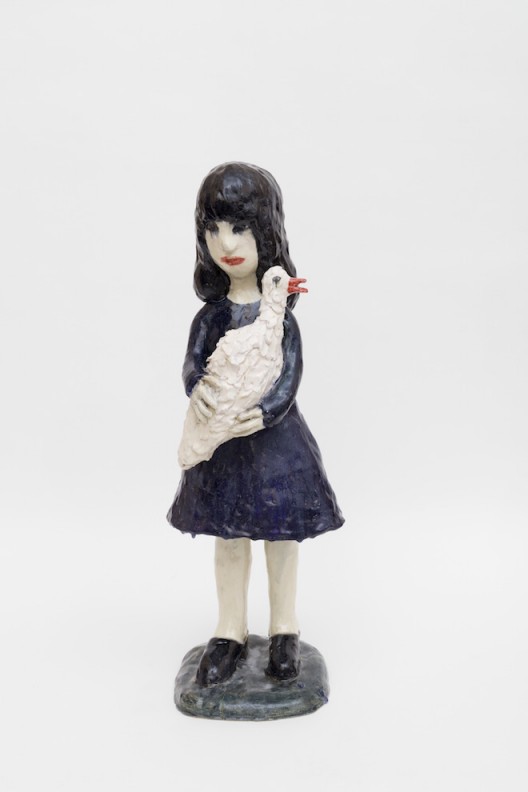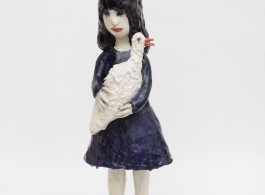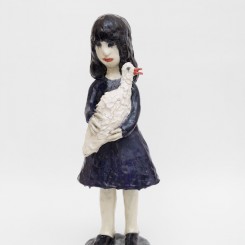Galerie Perrotin, Hong Kong is pleased to present “Hello Stranger”, the first solo exhibition dedicated to Swedish artist Klara Kristalova in Hong Kong, and her fifth solo show with the Gallery (Miami, Paris and New York).
The importance of being prepared
Klara Kristalova’s first name means cope in Swedish and the individuals in her art try to cope, just as Klara herself does. The connection between her name and the verb may seem meaningless, but in fact has a very palpable charge. Klara has had to cope since a young age, and this is reflected in her art. There is reason to regard her individuals, her creatures, as messengers from her past – as refugees and migrants moulded by her hands, but most of all by her fate and her dreams, linked to her as the candle is to the flame.
Klara’s hands work the stoneware clay quickly. It’s as if she’s sketching, impulsively and immediately – only in three dimensions. When the sculptures emerge from the kiln after the first firing, blind and unseen, Klara sets to work on them with base glazes and soft brushes, as if they were delicate watercolours and not corporeal clay figures. The application of colour brings them suddenly to life, giving them expression and context (Klara has a solid background as a painter). Finally she drenches them in transparent finishing glaze, as if to cool down the intensive working process before the figures are fired again. When they emerge from the kiln a second time, they’re like strangers to Klara’s eyes: the transformation is complete, unpredictable and eagerly awaited. The ever-surprising encounters with these unknown figures are at once the price and the reward for all her toiling with heavy clay in the blasting heat from the kiln – and she copes with that too.
If Klara’s figures could speak they would find that they speak many languages, just as many refugees do. As her parents did, who made the decision to flee with Klara in 1968, when she was barely one year old and the Warsaw Pact invaded their homeland, Czechoslovakia, during what became known as the Prague Spring. Hundreds of thousands of refugees were scattered across the free nations of Europe. After several itinerant years, the young family finally settled down in an abandoned school on an island in the Stockholm archipelago, in Sweden. Some time later her mother died unexpectedly of the most ordinary of illnesses – the common cold. One day a few years later the school was gutted by fire, and the remaining family was once again bereft of everything, even though it had already lost all it had.
The greeting of the exhibition title, Hello stranger, could be directed at Klara herself, as if the things she makes with her own hands welcome her, one by one, into their circle – rootless survivors, capable, dreaming, loyal to each other and to others as only those can who have lost country and language, love and context. Those who have lost everything, but who have therefore also been able to win everything back.
A lone, human-like dog who resembles Klara is wading waist-deep through existence, seeking her flock. She pricks up her ears mid-stride and cocks her head to one side.
It was the sailor who called to the stranger. He’s jostling with the other figures who have huddled like castaways on a raft, a life raft. When the Medusa sank in the Atlantic in 1816, its corrupt commander abandoned his crew and left everyone to die on a raft. His perfidy upset the whole world, and echoes can still be heard in our era. The French painter, Théodore Géricault, painted The Raft of the Medusa in 1819, depicting the moment when the last survivors sight the Argus on the horizon – the ship that finally managed to rescue a few remaining crew members. Klara reminds us that the last corrupt commander has yet to be born.
When Ulysses, the Greek hero-king of Ithaca, returned to his island from journeys to places where no-one had gone before, his faithful dog Argus was the only one who recognised his master. Klara is like Argus, the faithful dog who recognises the figures on the raft, her masters. They are her masters, the figures on the raft, for an artist doesn’t own her works since the work masters the artist. The artist as dog.
Klara has made her odyssey, and has returned to settle near her home island, in her archipelago. Just like Ulysses, she really has a faithful dog, and they’re as close as thunder is to lightning, so the dog’s name is Zeus after the king of the gods in Greek mythology. Zeus’ attribute is a lightning bolt.

In 1915 Vladimir Mayakovsky, the Russian poet, exclaimed in his famous long poem A Cloud in Trousers:
Of Grandfatherly gentleness I’m devoid,
there’s not a single grey hair in my soul! Thundering the world with the might of my voice, I go by – handsome,
twenty-two-year-old.
Gentle ones!
You lay your love on a violin.
The crude lay their love on a drum.
but you can’t, like me, turn inside out entirely, and nothing but human lips become!
In her art Klara thunders and turns inside out too, is also nothing but human lips – lips that kiss the world or devour it.
A lone figure, not in trousers but in a dress, a girl with two bare legs and two dresses and two bodies (and four arms), sort of, like a girl slipped over her vanishing mum. The mum’s legs, too long, support a girl who suddenly finds herself farther above the ground than she should be. How will she now cope, without falling, without an embrace to fall into? Far down there is the treacherous ground, implacably pulling and tugging at bodies and senses, at adults and children indiscriminately. They will all be drawn to earth, to graves, to sleep.
In the etching by Francisco Goya, The sleep of reason produces monsters, Goya is seen sleeping among his tools, tormented by winged imaginary animals that could have come straight from Klara’s kiln. It could be Klara slumped and dozing across the table, for her fired characters are fellow-travellers of Goya’s dreamt ones. The two artists can dream each other’s dreams and marvel at each other’s marvels. Appearance and reality devour each other and regurgitate each other. The flowers, the birds and the bees feast on each other when reason sleeps, as Goya depicts in his horrific suite, The Disasters of War.
The American composer, Cole Porter, sang in 1928:
And that ́s why birds do it,
bees do it Even educated fleas do it
Let’s do it, let’s fall in love
But the flowers and the bees remain as abandoned and cannibalistic as the castaways on the raft of the Medusa. Only the viewer still stands in the field of vision – today as in Goya’s day. And today the viewer can marvel at the astounding accord between Goya’s harrowing, black and white scenes, built with restraint from shadow and shade in the same way that Klara’s figures are now, with the occasional reconciliatory colour – but no more reconciliatory than a swirling drop of blood in a glass of water.
Before a solid shadow creating shade sits a black-and-white girl on a shelf, as above an abyss of irrationality and disasters; in another place a motionless snow mum stands at attention, trying to shade her dormant snowballs. Light and shade, sleep and waking, life and death, struggle and flight. Can a snow mum catch cold? Or does she just slowly melt away in tears, turning into her children’s pools of tears when they wake? Will they cope? Klara will help them. In Swedish, Klara also means prepared.
Klara has been prepared since before she was born, since Goya’s day. Goya’s day is now, perhaps more than it was then, before photography had been invented and the viewer could still deceive himself into believing that the scenes in The Disasters of War were merely morbid, sadistic fantasies. But Klara knows better, she trusts Goya.
In a dense cluster of cuddly animals and others that are very much alive – both types profoundly capable of communicating and cooperating with humans – in that cluster is Klara. And there, on her own head, she herself perches unborn. The inscrutable smile makes me wonder at first, then I understand – it’s Goya! Hello stranger!
Dan Wolgers, member of the Royal Academy of Fine Arts, Sweden (translated by Tomas Tranæus)


